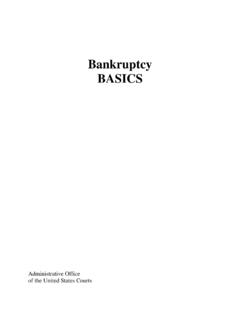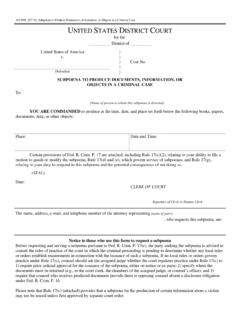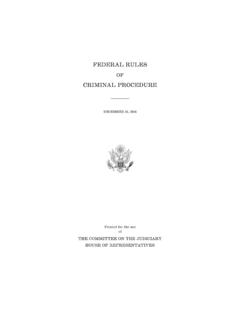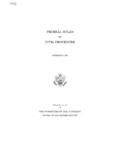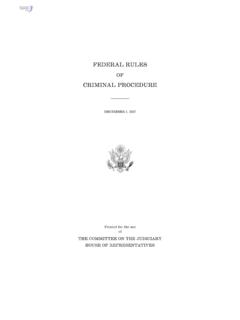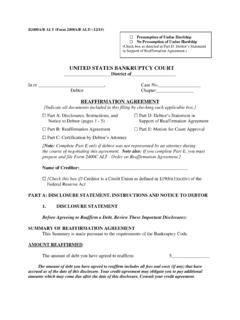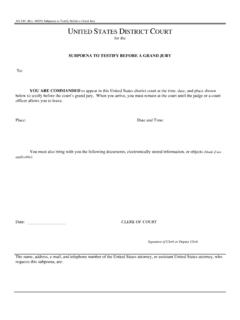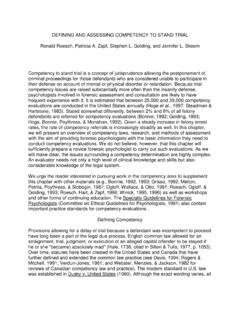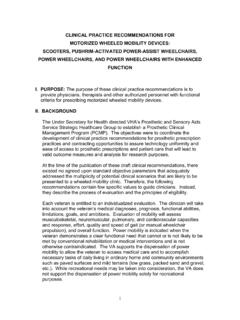Transcription of An Examination of Deterrence Theory: Where Do We Stand?
1 33 December 2016 An Examination of Deterrence theory : Where Do We stand ? Kelli D. Tomlinson Tarrant County Adult Community Supervision and Corrections Department Deterrence theory HAS been the underlying foundation for many criminal jus tice policies and practices throughout the course of American history. Although it was once the dominant theory within the realm of criminology, it now competes with other devel oping, more comprehensive and integrated theories about criminal behavior such as life course theory or Agnew s general theory of crime. Criminologists have relentlessly tested Deterrence theory using scientific methods to assist in informing and educating policy makers, as well as to unravel the mystery of crime reduction.
2 This essay first examines the theory , including the main tenets, the inher ent assumptions of the theory , and the goals set forth by the theory . An inductive content analysis of numerous scholarly, peer-reviewed articles was conducted to identify key themes in the literature pertaining to Deterrence and to ascertain whether or not the goals of the theory have been met, as evidenced by scientific test ing. Whether or not the theory did achieve its intended goals will be addressed throughout the essay. Last, I present a summary of the major findings and commentary on the overall utility of the theory . Overview of Deterrence theory Modern Deterrence theories have their foun dation in classical criminological theory derived mainly from an Essay on Crimes and Punishments written by Cesare Beccaria, an Italian economist and philosopher, in 1764, and from An Introduction to the Principles of Morals and Legislation (Introduction to the Principles), written in 1781 by Jeremy Bentham an English philosopher, jurist, and social reformer.
3 Beccaria s treatise was nota bly the first concise and orderly statement of standards governing criminal punishment and called for major reform in the criminal jus tice system. Although not the main purpose of his work, contained within his essay was an underlying theory of criminology which argued that individuals make decisions based on what will garner them pleasure and avoid pain, and unless deterred, they will pursue their own desires, even by committing crimes (Beccaria, 1986 [1764]). Bentham s work has developed a more broad and general theory of behavior than did Beccaria s, and his work has been credited with being the forerunner to modern rational choice theory (Bentham, 1988 [1789]). Additionally, classical theory posits that punishments should be swift, certain, and proportionate to the crime in order to appro priately deter individuals from violating the law.
4 Beccaria called for laws that were clearly written and for making the law and its corresponding punishments known to the public, so people would be educated about the consequences of their behavior. These basic principles of classical theory would later come to be known as Deterrence theory . Deterrence theory was revived in the 1970s when various economists and criminologists began to speculate about the topic again, not only as an explanation for why people commit crime but also as a solution to crime (Pratt et al., 2006). The principal assumptions made by the theory include: (1) a message is relayed to a target group [ , it is wrong to murder, and if you take another s life you could go to prison or receive the death penalty]; (2) the target group receives the message and perceives it as a threat; and (3) the group makes rational choices based on the information received.
5 Assumption one is the easiest to achieve: Most people are aware that it is wrong to murder or steal, etc., although they may not be aware of the specific penalties for crimes other than murder. Assumptions two and three, however, are more problematic. The conjecture is made that everyone will be threatened by the sanction for the crime; however, this is not always the case. For some individuals, being arrested and serving time in jail or prison is a way of life. In addition, people do not always make rational choices, especially while under the influence of drugs and/or alcohol, which research shows a fair number of arrestees are at the time of their offense (Chapman et al., 2010). As a final comment, it might be noted that Deterrence theory is both a micro- and macro-level theory .
6 The concept of specific Deterrence proposes that individuals who commit crime(s) and are caught and punished will be deterred from future criminal activ ity. On the other hand, general Deterrence suggests that the general population will be deterred from offending when they are aware of others being apprehended and punished. Both specific and general Deterrence , how ever, are grounded in individuals perceptions regarding severity, certainty, and celerity of punishment. It is essential to understand how perceptions of these factors do or do not translate into criminal behavior. Perceptions of Punishments Much of the scholarly literature pertaining to Deterrence theory examines the certainty, 34 FEDERAL PROBATION Volume 80 Number 3 celerity (or swiftness) of punishment, and severity, and their intended effects on offend ers (Bailey & Smith, 1972; Geerken & Gove, 1977; Paternoster, 1987; Howe & Loftus, 1996; Maxwell & Gray, 2000; Nagin & Pogarsky, 2001).
7 For example, if when a person commits a crime the likelihood of being apprehended is high and that he or she will be swiftly punished and severely enough, these outcomes and their teaching effect will deter the person (as well as others) from committing future crimes. Any delay between the commission of an offense and commencement of its associated punish ment is postulated to reduce the deterrent effect of the sanction. Furthermore, if the pun ishment for the crime is not severe enough to cause sufficient discomfort or inconvenience to the actor, he will not be deterred from engaging in additional criminal acts. These underlying assumptions of the theory point toward a linkage between perceptions and the actions on which they are based. Research regarding severity, certainty, and celerity has shown mixed results.
8 Severity of punishment was once thought to deliver the main deterrent effect; the more severe the consequence for law-breaking, the less likely an individual is to commit a crime. However, this assumption has not been supported in the literature (Paternoster, 1987; Schneider & Ervin, 1990; Kovandzic, et al., 2004; Kleck et al., 2005; Paternoster, 2010). Kleck et al. com mented that although increased punishments may in fact reduce crime, this reduction can also be attributed to incapacitation effects (large number of offenders incarcerated), not necessarily to general Deterrence (2005). The United States has experienced an incar ceration binge over the last several decades; in 1980 there were approximately 501,886 incarcerated persons in prisons and jails, and at year-end 2009 there were 2,284,913.
9 These figures do not include probation or parole; when probation and parole figures are added in, the total number of individuals under some form of correctional supervision in 1980 was 1,840,400, increasing to 7,225,800 in 2009 (BJS, 2010). Although crime rates in the did steadily decline over several decades, this cannot be solely attributed to Deterrence , but to incapacitation effects and possibly to changes in police activity (Paternoster, 2010). And in fact crime rates in the remain higher than in any other Western nation. Several forms of punitive, Deterrence -focused legislation are responsible for this dramatic increase in imprisonment rates. Sanction threats such as three strikes laws in the early 1990s were partly responsible for the increase in incarcerated offenders, as well as other sentencing initiatives such as man datory minimums and truth-in-sentencing laws.
10 Three strikes legislation was touted as a deterrent to serious offenders due to reduced judicial discretion (increasing cer tainty) and increased severity in penalties. Yet, after much empirical testing, researchers have found no significant deterrent effects for such laws (Males & Macallair, 1999; King & Mauer, 2001; Kovandzic, 2001). This may be because these laws did not take into account a person s many other factors that have been correlated with criminal conduct, such as age, gender, impulsivity, mental illness, antisocial personality disorder, etc. (Ellis, Beaver, & Wright, 2009). In addition, some research has shown that these laws may have an inverse effect that is, to increase crime (Kovandzic et al., 2004). Schneider & Ervin s (1990) research showed that people who had been punished more severely actually engaged in more crime; this could be due to the punishment creating a chain reaction of other events which reduce individuals opportunities for conventional behavior ( , stable employment, close fam ily ties) and weakening of social bonds.
